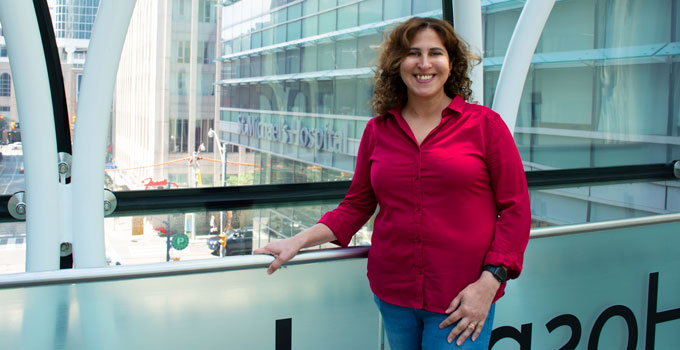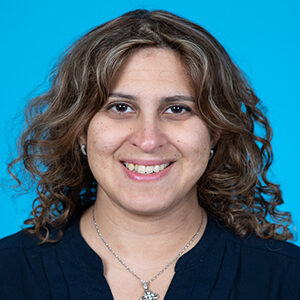Dr. Rola Saleeb, a pathologist and researcher at St. Michael’s Hospital, Unity Health in Toronto and the University of Toronto is the latest recipient of an OICR Investigator Award. Saleeb’s appointment as an OICR Clinician Scientist will allow her to undertake her innovative research while maintaining a clinical role. In this Q and A, Saleeb talks about how she hopes to improve the clinical practice of pathology through research, her career journey, and the positive impact of OICR’s past and current support.
What is the focus of your research and what sort of projects are you currently engaged in?
My two main areas of research are kidney cancer and molecular pathology – sometimes these interests are combined, sometimes not. I am working to develop ways to combine a kidney tumour’s morphology (the way it looks under the microscope) with its molecular or genetic makeup. Through this approach we can improve clinical care by better classifying tumours to provide more-accurate predictions of outcomes or response to therapy. I am also interested in molecular testing across cancer types and in increasing its use in the clinical setting by developing ways to overcome existing barriers.
How has your clinical role influenced your research?
As a genitourinary pathologist my job is to give clinicians such as medical oncologists, radiologists and urologists the information that they need to manage a patient’s tumour. In my day-to-day work I am examining kidney, bladder, urethral and prostate cancers under the microscope to determine the specific type and stage of cancer and to provide a prediction of its aggressiveness. But not everything can be foretold by the microscope, which is why I think it is important that we continue to improve our ability to integrate tumour biology into our work as pathologists. I want to be able to provide my clinical colleagues and patients with the most accurate and useful information I can.
What do you see as challenges to increasing the use of molecular pathology in the clinic?
Early in my clinical career I became interested in genetic testing as a research area because I saw that despite its value, blocks remained to it being an easily accessible and common tool to aid in the management of cancer. Genetic testing often involves expensive tools and large pieces of lab equipment that can strain existing, limited lab space. Another issue is that genetic testing for cancer usually requires multiple tests, taking up more pathologist time and other resources. Lastly, it can take weeks for some of these tests to be processed and results provided, reducing their clinical utility.
How does your research aim to find solutions to these issues?
My collaborators and I have set out to develop a quicker, more efficient and less resource intensive approach to genetic testing. We are doing this by combining the cutting-edge technologies of next-next generation sequencers and genome engineering techniques, an approach we believe could return results to clinicians and patients within days. We are selectively targeting parts of the DNA that we want to analyze, meaning we save time by not sequencing the entire genome. We have also streamlined the process by being able to test for multiple biomarkers in a tumour at the same time, eliminating the need for multiple, individual tests. By personalizing testing and using smaller and less expensive equipment we can bring this approach to hospitals big and small and make a real difference for patients.
You were previously an OICR Transformative Pathology Fellow and received support from the Ontario Molecular Pathology Research Network (OMPRN). What has OICR’s support meant for your research and your career?
I applied to the Transformative Pathology Fellowship while doing my pathology residency and it really changed my entire career trajectory. It led to me pursuing a master’s degree and eventually a PhD and put me on the path towards clinical science and molecular pathology. The support from OMPRN was also key as it, along with the Fellowship, allowed me to publish some of my first research in the area and establish myself as a researcher.
You are now taking on a new role in the OICR community as a Clinician-Scientist. What excites you most about this position?
This is a really great opportunity because it allows me to do what I want to be doing and that is being an active pathologist and combining that with my efforts as a researcher. Having time set aside to be a scientist means that I will be able to really bring my experiences as a pathologist to bear and work to bridge the gap between research and the clinic. I am so thankful for the support and am excited to continue working alongside the amazing researchers of the OICR community.


